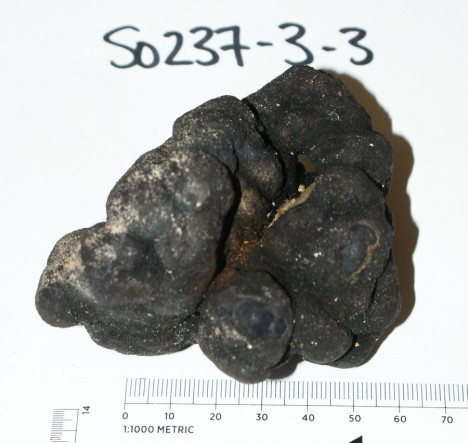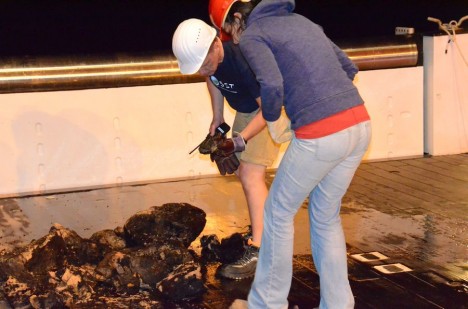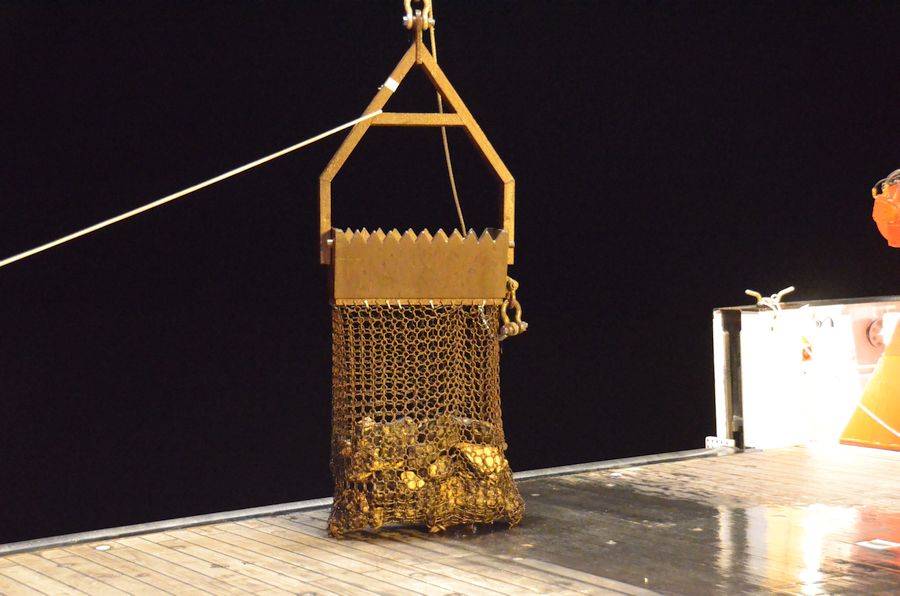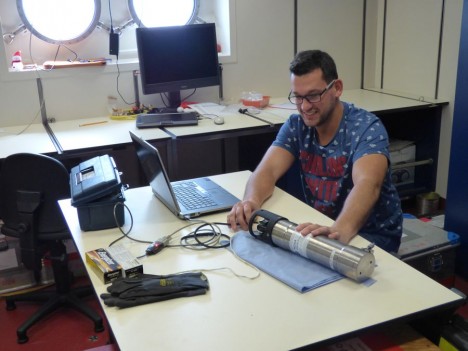Frohe Weihnachten wünscht Expedition SO237
Diese Weihnachten haben wir damit verbracht, einige der Gesteinsproben, die wir auf der ersten wissenschaftlichen Station gesammelt haben, zu katalogisieren.
Für Geologen ist das Beproben von Gesteinen der ozeanischen Kruste eine fantastische Weise, um die Entwicklung der ozeanischen Kruste unseres Planeten, die hydrothermalen Systeme und den Wärmehaushalt der Erde und zu studieren.
Um Proben zu bekommen verwenden wir eine Gesteinsdredge (ein geschleppter Metalrahmen mit Kettennetz). Es gibt zwei Arten von geologischen Dredgen und die, die wir hier verwenden, wird als Kettensack-Dredge bezeichnet. Eine weitere ist die Tonnendredge.
Die Dredge wird an einem Drahtseil auf den Meeresboden herabgelassen und dann vom Schiff über den Grund gezogen. Befinden sich Steine oder hydrothermale Ablagerungen am Grund, wird die Dredge Proben davon beim Schleppen im Kettensack sammeln. Wenn die Dredge wieder zurück an Deck ist, nehmen Wissenschaftler wie Dominik und ich den “Fang” entgegen. Das ist der Zeitpunkt, an dem die Arbeit richtig beginnt!
Als erstes geben wir den Biologen an Bord die Möglichkeit alles biologisches Material von der Oberfläche abzusuchen.
Danach waschen wir das Material der Probe (Steine und Sedimente), erfassen es und beschreiben das Aussehen und die Zusammensetzung. Oft kommt es vor, dass wir die Steine durchschneiden müssen, denn der Kontakt mit dem Seewasser kann mit zunehmenden Alter die Oberfläche verändern und dazu führen, das sich neue Mineralien auf den Steinen ablagern. Für diesen Zweck haben wir eine Gesteinssäge mit an Bord gebracht.
Während dieser Expedition versuchen wir die Zusammensetzung der ozeanische Kruste und ihre Veränderungen im Laufe der Zeit zu untersuchen.
Die VEMA Bruchzone ist der perfekte Ort hierfür, denn es gibt es eine Art Bruchkannte, ein Fenster in die Kruste, (Was die Beprobung leichter macht) und während wir in Richtung des mittelatlantischen Rückens fahren (wo die tektonischen Platten, die die Ozeankruste bilden, sich auseinander bewegen und neuer Meeresboden entsteht) wissen wir, dass die Erdkruste immer jünger wird.
Wir haben die Dredge jetzt einmal an einer Stelle eingesetzt von der wir vermuten, dass die Erdkruste ungefähr 160 Millionen Jahre alt ist, und viel interessantes Material an Bord geholt. Weil die Kruste hier sehr alt ist, gab es über Millionen von Jahren die Möglichkeit, dass sich herabsinkendes Sediment wie Schlamm auf der Kruste aufgelagert hat. Darum waren wir besonders froh, dass die Probennahme erfolgreich war. Das meiste Material in der Probe besteht aus Mangankrusten und Manganknollen. Mangan wird nicht wie die meisten Gesteine, die wir untersuchen, am Mittelatlantischen Rücken durch Eruptionen hervorgebracht, sondern lagert sich aus dem Seewasser auf festen Oberflächen oder in der Form von Knollen im Sediment ab. Diese Knollen nehmen wir mit zurück nach Deutschland, damit sie dort von Spezialisten untersucht werden können.
Außer für die Gesteinsprobennahme ist unser Team auch für die sogenannten MAPR (Miniature Autonomous Plume Recorders) zuständig. Die VEMA-Bruchzone ist eine alte Verwerfung. Das bedeutet, sie ist ein großer Bruch in der ozeanischen Kruste, der die Bewegungen der tektonischen Platten aufnimmt, die hier aneinander vorbei gleiten. Fluide (Flüssigkeiten in der Erdkruste), erwärmt vom heißen Magma tief unter Kruste, nutzen diese Bruchstellen und Auffaltungen als Austrittswege. Je näher man dem Mittelatlantischen Rücken kommt, desto dünner wird die Kruste, desto näher ist das Magma und die Fluide können höhere Temperaturen annehmen. Deshalb könnte sich hier ein Gebiet mit hydrothermaler Aktivität befinden.
Hydrothermal aktive Gebiete befinden sich dort, wo heiße Fluide (von zehn bis einige hundert Grad Celsius) aus dem Meeresboden austreten und mineralische Ablagerungen bilden. Die bekanntesten dieser Ablagerungen sind die “Black Smoker” –“Schwarze Raucher”, bei denen das heiße Wasser viele gelöste Metalle enthält, die ausfallen, wenn die heiße Flüssigkeit mit dem kalten Seewasser in Berührung kommt. Es bildet sich eine Rauchfahne (die eigentlich kein Rauch sondern eine feine Partikelwolke ist) und diese Schwaden erzeugen physikalische und chemische Anomalien in der Wassersäule. Die Temperatur, Trübung und chemische Reduktionsfähigheit des Seewassers können von der Gegenwart der hydrothermalen Rauchfahnen beeinflusst werden. Diese Veränderungen können wir mit dem MAPR messen. Dieses Gerät wird an einem Kabel befestigt und bis auf wenige Meter über den Meeresgrund herabgelassen, wo es alle paar Sekunden eine Messung durchführt. Wenn der MARP wieder zurück an Bord ist, werden die gesammelten Daten ausgewertet, um Hinweise auf mögliche hydrothermale Quellen am Grunde des Ozeans zu finden.
Dominik Palgan und Khalhela Zoeller
Dredging und MAPR Team
PhD Candidates, GEOMAR
[English]
Merry Christmas from SO237
This Christmas we have been busy cataloguing some of the rock samples we collected at the first science station. For geologists, sampling the ocean crust is a fantastic way to study the world’s thermal budget, hydrothermal systems, and the evolution of our planet. In order to retrieve samples, we use a piece of equipment called a dredge. There are two types of dredge and the one we are using is called a chain bag dredge. The dredge is lowered to the seafloor and then dragged along the bottom of the ocean. If there are rocks exposed on the seafloor, or hydrothermal deposits, the dredge will travel over them and pick up samples that are collected in the dredge bag. When the dredge is brought back on deck the scientists, like Dominik and I, collect them. That’s when the real work begins! First we give them over to the biologists to remove any biological material living on them. Then we wash them, label them and describe their appearance and composition. Often we need to cut the rocks in half because the seawater has altered the surface or deposited new minerals on it. To do this we use our onboard rock saw.
During this cruise we are attempting to sample the composition of the crust and observe the alteration through time. The VEMA transform is the perfect place to do this because it is a cliff (which makes it easier to sample) and as we travel towards the Mid-Atlantic Ridge (where the tectonic plates are moving apart and new seafloor is being constructed) we know the crust is getting younger. We have already conducted one dredge on crust we expect to be around 160 million years old and brought back lots of interesting samples. Because the crust is very old it has had lots of time for sediments, like mud, to accumulate on top of it, so we were lucky to get any samples at all. Most of the samples we collected were of manganese crusts and nodules. Manganese does not erupt along Mid-Ocean Ridges, like most of the rocks we are interested in, but is instead deposited from the seawater onto surfaces and in nodules. These nodules will be taken back to Germany where they will be analysed by specialists in the field.
In addition to dredge work, our team is also responsible for the MAPR (Miniature Autonomous Plume Recorders). The VEMA-Transform is an old fault; this means it is a big crack in the oceanic crust that used to accommodate the motion of plates slipping past each other. Fluids use this fracture and associated faults as pathways and, as where get closer to the Mid-Atlantic Ridge, the crust is thinner and therefore there are higher temperatures at shallower depths. Therefore, it might be a location in which hydrothermal activity can be detected. Hydrothermal fields are where hot fluids (from tens to hundreds of degrees Celsius) exit the seafloor and form mineral deposits. The best known of these are black-smokers, where the hot water is carrying lots of dissolved metals that precipitate when the hot fluid interacts with the cold seawater. When the hot fluid interacts with cold seawater a plume (smoke cloud) can form. These plumes tend to cause anomalies in the water column; temperature, turbidity (how light propagates through the seawater) and the reducing potential of the seawater may all be affected by the presence of a hydrothermal plume. We can test for all these things using the MAPR. These pieces of equipment are attached to cable and lowered down to within a few metres of the seafloor and record measurements every second. This dataset is analysed when the MAPR’s are brought back onto the ship and the data can be used to pinpoint the likely position of hydrothermal venting on the seafloor.
Dominik Palgan and Khalhela Zoeller
Dredging and MAPR Team
PhD Candidates, GEOMAR

Manganknolle von Station 1. 21/12/2014 / Mn-Nodule from science station 1. 21/12/2014. ©Khalhela Zoeller

Fahrtleiter Colin Devey und Khalhela Zoeller bei der Erstbegutachtung / Chief Scientist Colin Devey and Khalhela Zoeller doing initial examination of the samples. ©Thomas Walter


Dear “Sonne”-Team,
during your stay at die Hamburg habor I had the opportunity, to visit your extraordinary ship and speak with members of the nautical crew an the scientists. As a journalist I’m very interested in your journey. It’s an outstanding occasion, to follow the route and read all reports about the first results of your daily life on board of the “Sonne”. I’m looking forward to learn more.
All the best wishes from Hamburg
yours Diethart Goos